- The construction of the Indoor Practice Facility is nearly finished (see Big Green Alert). The school’s existing indoor practice facility, Leverone Field House, is being eyed as a site for a temporary hospital ward during the pandemic (Valley News). The west wing of Alumni Gym is also under consideration (Valley News).
- This interesting tidbit appeared at the end of a board news release about new trustees:
The new board members were elected at the board’s spring meeting, held this year at Stanford University in Palo Alto, Calif.
That seems like a first. The main news release (issued 1 March) has more information:
The board met at Stanford University in Palo Alto, Calif., where they engaged in wide-ranging conversations with a diverse group of Stanford leaders including trustees, the former and current presidents, the provost, faculty in leadership positions, and representatives from departments across campus.
Not sure what to make of that, whether the learning opportunities were added to enhance the remote meeting or the meeting was held on the other side of the continent specifically in order to learn from Stanford.
- Shattuck’s Revenge. At the Stanford meeting, the board approved a capital budget to fund projects that include “include renovation of Thornton Hall; planning and design of the Dartmouth Hall renovation; planning for proposed projects with private developers, including graduate housing and energy infrastructure; and” other projects. An interesting mention is made of $3 million “for planning and schematic design to explore the renovation and expansion of the Choates residence halls and the East Wheelock residential complex,” and funding for the future Hop renovation (still on the table!) and construction of teaching and research spaces is also noted. Not a word, however, on the Crosby Street dorm, which has been in planning for more than two years now. The project page for the design of the building was quietly removed from the Campus Services website during the last few weeks.
- Irving Oil Co. has a rendering of the Irving Institute that differs in detail from the other images out there.
- The college launched its capital campaign two years ago at Duggal Greenhouse in the Brooklyn Navy Yard. Some photos from the event show considerable attention to detail: the use of Dartmouth Ruzicka lettering on the front facade; the model (15′ high?) of the bonfire, reimagined as a cocktail table; and the plaster/pasteboard renderings of Baker Tower and the main buildings of Tuck, Thayer, and Geisel (it’s white, but it’s a reasonably accurate rendition of the school’s ex-hospital building on Maynard Street).
- Unrelated even to architecture: Although it is not unusual to hear of a company that has been operating since 1905, it is unusual to find one that has been making the same product since its beginning. How odd would it be if that product were a Morse code key? Take a look at Vibroplex and its Original Standard key. This is not quite an example of Ferry Porsche’s theory that the last car ever to be built will be a sports car (see Porsche’s site), because the FCC seems to effectively subsidize the use of Morse Code by prohibiting other modes of communication on certain radio frequencies, but it is close.
Category Archives: Leverone Field House
New building projects and other topics
- The Valley News has an article on the 50th anniversary of the Parkhurst takeover.
- The DOC House at the head of Occom Pond is going to be renovated when there are enough donations.
- The Library is working with Russell Scott Steedle & Capone Architects, Inc., to design a new off-site storage facility:
Dartmouth plans to build a 20,000 sq ft stand-alone, purpose-built storage facility to house the library’s low-use print collections and College records. This facility, to be located on Dartmouth’s 56 Etna Road property in Lebanon, will replace the existing Library offsite storage facility[,] which is full. - An article in The Dartmouth details progress on the Indoor Practice Facility (this is the controversial project in the Sunken Garden) and Campus Services has information on the progress of the Boathouse addition.
- The year the bookstore died: Earlier this year, both the Dartmouth Bookstore (ca. 1872) and Wheelock Books (1993) closed up.
- Now that the Dartmouth Bookstore is gone, the Gitsis Building is being heavily renovated, the Dartmouth reports:
The building’s owner, Jay Campion, said that the renovations are already well underway and should be complete by July, which will allow the three tenants to start setting up their shops. According to Campion, the renovation process has involved a complete makeover.“We’ll be rebuilding the entire storefront and have basically gutted the building,” Campion said. “We’re re-insulating and replacing the heating and air conditioning systems for this and dividing the space for the three separate tenants on the first floor.”
- This public domain collection of images from the National Archives has an interesting group of photos of campus during WWI. Most of them show the trenches that were dug behind the gym, presumably where Leverone stands today. This photo shows a group of cars and trucks parked inside the southeast (or possibly northwest) corner of the gymnasium itself.
- Another new project: Renovations of the bluestone plaza in front of the Hopkins Center. The paving stones will be replaced with concrete pavers.
- Wilson Architects have posted an updated flythrough of the Thayer/CS Building. Now it is clear that the retaining wall to the west is actually the entrance to the garage; in this rendering, it is just vegetated rather than topped by a parapet and walkway.
- Not sure whether the new Planning, Design and Construction website has been mentioned here.
- In this Street View the Google employee with his camera backpack is reflected in the windows of Berry Library — as he walks through campus tour group.
- This post at Granite Geek solves the mystery of whether the NHDHR database called EMMIT is a reference to the derogatory student term “Emmit,” meaning a local person (or really, a New Hampshireman, not so much a townie). The answer is no.
- Lawrence Biemiller has a piece in the Chronicle of Higher Ed called “Make Way for Trenches! A College Plans to Scrap Its Entire Heating System.” It has good information on the upcoming heat plant and steam-to-water transition projects.
- When the new biomass plant is completed, the college will decommission the old heating plant behind New Hampshire Hall. Then it will have an empty building, historic and full of character and eminently reusable, right in the middle of the Arts District. The current feeling seems to be that the building will be demolished, along with its landmark smokestack. Here’s hoping that either or both can be saved, and if they are to be destroyed, at least they can be thoroughly documented first. The University of Virginia is doing the right thing by scanning University Hall, a 1965 domed concrete basketball arena.
- The Anthropology Department is leading n archeological aexcavation of an 18th-century house site on campus. That’s fantastic. It’s a pity that no one was doing this in the 1930s (or even the late 1980s, before the construction of the steam tunnel disturbed the east side of the Green).
- Unrelated: A week and a half ago, Union Pacific 4014, a 1940s steam locomotive with a 4-8-8-4 wheel arrangement, was brought back to life. Having seen a couple of Big Boys in impossibly derelict condition in Colorado and Wyoming in my youth, I never thought one of these locomotives would run again. Here’s a film of the colossus, double-headed with UP 844 (a 4-8-4): Film by Jaw Tooth. Here’s another clip by airrailimages. Astonishing.
250th anniversary planning heats up
-
One might be surprised at paucity of info out there on the demolition of a part of the Hood Museum and the construction of a large addition. The D has a demolition photo from the Green taken last fall. Curbed.com has a post with two post-demolition photos. (See also the set of fascinating photos of the architectural model at Radii Inc.)
-
Metropolis does have a story on the Hood. These are excerpts:
Dartmouth first began seriously mulling over the Hood’s fate in 2001, when it commissioned a speculative study by Rogers Marvel Architects. In 2005, it commissioned another by Machado Silvetti, the architectural firm that designed the Hood’s newest neighbor, the Black Family Visual Arts Center. Then in 2010, it commissioned yet another study, this time by Centerbrook, the practice that Charles Moore cofounded afterparticipatory process, which put users on a level playing field Moore Grover Harper. None created the visual presence — that new front door — that Dartmouth administrators were looking for.
The college began soliciting proposals from a broader pool of architects. A selection committee, including faculty and administrators, winnowed down a short list. In the end, four architects were selected to be interviewed. John Scherding, director of campus design and construction, vividly remembers the TWBTA proposal:
“All of us in the room felt it was brilliant. They were the only firm that suggested disconnecting the Hood from Wilson Hall, allowing Wilson to stand proudly on the corner of the Green. They were the only firm that showed a strong identifiable front entrance to the building, infilled the courtyard to provide program space, and really strengthened the north-south axis. It was a very powerful and simple concept that satisfied all of the needs.”It thoughtfully preserves the gallery spaces (one exemplary detail: To preserve the windows along the staircase, and the dance of light along the walls, TWBTA will convert some of the windows into light boxes of stained glass) and will likely improve the museum experience in many fundamental ways.
-
The sestercentennial celebration website is up. The wordmark makes some interesting typeface choices. The unique “250,” which is set in a type that might be based on Bodoni, includes the most arresting element: a numeral “2” whose diagonal (neck?) is partially erased. The numeral “5” is partially hidden by the “2,” but there is no explanation for the missing bit of the “2.” Is it meant to look like the imperfect printing of an eighteenth-century pamphlet? It looks a bit like a stencil. In any case, the “Dartmouth” on the second line is set in the official Bembo (standard Bembo, not the Yale-only version), and the third line (“1769-2019”) is set in a sans serif font.
-
The sestercentennial will involve a year-long program of events (President’s message) created by a planning committee seeking to meet a number of goals.
-
Here’s a clever little film about an interesting story: Goudy & Syracuse: The Tale of a Typeface Found.
-
Interesting insignia decisions here: the midcentury Institute of International Studies in California was acquired a few years ago by Middlebury College (Wikipedia). In 2015, Middlebury “introduced a brand identity system that embraces the full breadth of its educational endeavors by placing the Middlebury name on each of its schools and programs” (MIIS page). And what a varied collection of institutions it is, including summer schools, conferences, and academic programs. The unified identity is based on a shield. I don’t know about the Midd shield: the globe looks like it’s from a different design language, from a 1960s U.N. brochure. The chapel touches the top of the shield. The hills, because they meet the edges of the shield, read as the sleeves of a gown or as curtains. Maybe this is because the eaves of the chapel are shown as angled bars floating free on the clouds.
-
The Institute is the only Middlebury institution that gets a truly distinctive shield, a variation “that replaces the Green Mountains of Vermont and Old Chapel with the historic Segal Building from the Monterey campus and the year of the Institute’s founding” (MIIS page).
-
A Kickstarter project for Design Canada, “The first documentary chronicling the history of Canadian graphic design and how it shaped a nation and its people.”
-
The New Yorker has has an article on lines of desire. Speaking of unplanned paths, the aerial photo of the vacated pipeline protest camp in the New York Times is remarkable.
-
McGraw Bagnoli Architects have published a brochure about the firm that details the five urban design projects planned by William Rawn Associates during the early 2000s. This is fascinating. It will be interesting to see whether the school ever completes the Sargent Block project and what plan it follows.
-
Smith & Vansant have photos of some of the houses the firm has renovated for the college, including Unity House and Thayer Lodge, both on South Park Street, 26 East Wheelock, 19 South Park, and the Victorian professor’s house of the North Park House community.
-
Architect Vital Albuquerque (again, great name) < ahref="http://rwu.edu/academics/schools-colleges/saahp/portfolios/alumni/vital-albuquerque-class-01">presents more unreleased renderings of the unbuilt NCAC, including a remarkable photo of a model of the project.
-
Engelberth Construction has its page for the West Stand Replacement up.
-
At the last board meeting,
Hanlon outlined goals to renovate a number of aging buildings, and the board approved funds to proceed with a schematic design for the renovation of Dana Hall, the former home of the biomedical library located at the north end of campus, to facilitate the expansion and improvement of faculty office spaces.
The board also approved a capital budget of $30 million to fund a number of projects, including the Morton Hall renovation and planning and feasibility studies of the abatement and demolition of Gilman Hall; renovations to Reed Hall and Thornton Hall; and undergraduate housing expansion and renewal.
-
A Moosilauke update with photos by Eli Burakian. The building has an interesting mix of construction techniques. Some of those “character” timbers are fantastic.
-
Some of the photos of the federal building that houses the Ninth Circuit Court of Appeals, such as the one in this New York Times story from February 9, show the elaborate metal lanterns flanking the entrance of the 1905 building. The lanterns might be familiar: architect James Knox Taylor, then Supervising Architect of the Treasury, modeled them on the torch-holders of Palazzo Strozzi in Florence of 1489 (GSA page on the Browning U.S. Court of Appeals Building). The Strozzi torch-holders also inspired Charles Rich in his design for Parkhurst Hall (1913).
-
Drove past Nervi’s SCOPE arena in Norfolk, Va. (1971-72) last weekend and admired the ribs that form the roof of this entrance pavilion (Google Street View):
Indoor Practice Facility at the “Sunken Garden”?
Bruce Wood at BGA wrote a week ago Saturday about the inflatible stadium bubbles that some schools use for offseason sports practice:
Keep your eyes and ears peeled for news out of Dartmouth and it won’t be about a bubble. Those who attended the Friends of Football semiannual meeting in June heard the details but nothing has been officially released yet.
A guess: The news will be about the Indoor Practice Facility slated for the practice field beyond Thompson and the Boss Tennis Center. Almost four years ago the Alumni Magazine wrote that “Sheehy’s hopes for the future include the building of an indoor practice facility[.]”1Brad Parks, “It’s a Whole New Ballgame,” Dartmouth Alumni Magazine (Nov.-Dec. 2011).
The designers of the future facility are Sasaki Associates, the firm that has been working on the “residential colleges” plan.
——-
| ↑1 | Brad Parks, “It’s a Whole New Ballgame,” Dartmouth Alumni Magazine (Nov.-Dec. 2011). |
|---|
Incubator progress; other items
- A nice Burakian aerial from above the Chase Field athletic complex in the foreground shows the potential of Piazza Nervi.
- A little more on the NCAC: it was not noted before in reference to the Alex Atwood rendering that the building’s extensive underground space was to have had at least two skylights in aboveground lanterns, almost like Pei’s Pyramid at the Louvre.
- More on Hillflint, the clothing company mentioned here in October, from Dartmouth Now. Turns out it was started by John Shi ’12.
- The school’s Flickr photostream has a photo of the interior of Rauner showing some of the presidential portraits. I don’t recognize the background of President Kim’s portrait — a room in Baker, perhaps?
- Outgoing Board Chair Steve Mandel did not mention any potential construction when he wrote:
[T]he new living arrangements will embrace the concept of the “house system.” Students will live together not only in their freshman year but also in upper-class residence clusters for their three remaining years. Investments in academic programming and affiliated faculty are planned to foster community in these residential clusters… These changes should reintroduce a dorm-based sense of identity for undergraduates.1Letter from Chairmain of the Board of Trustees Steve Mandel (21 March 2014).
- The Big Green Alert Blog dissects the seating figures for the new West Stands with reference to an article on the project in The D. It looks like the replacement stands will cost 2,312 seats. For reference, the current capacity of all of the stands at Memorial Field in total is about 13,000.
- The D also writes on a planned expansion of the enrollment, faculty, and curriculum of Thayer School. No word yet on new buildings, but they seem inevitable, especially on the parking lot south of the McLean ESC.
- An Incubator progress photo has been posted by Dartmouth Entrepreneurial Network. Four Currier does seem a great place for it — downtown, in a commercial building, and yet on college property right next to campus. NHBR article notes the hiring of director Jamie Coughlin from the abi Innovation Hub in Manchester. An article in BusinessNH Magazine paraphrases Coughlin:
He says the new 3,000-square-foot space is designed like the abi with open collaboration in mind, to host residencies for entrepreneurs, and help connect students with executives, faculty, and investors.
- Did you know that the Dartmouth Entrepreneurial Network has a residential program?
- DHMC News announces the receipt of a gift to fund the construction of a substantial hospice care center. The hospital is still looking for a site.
- And DHMC has received the Legacy Project Award from the American College of Healthcare Architects. The press release states:
Dartmouth-Hitchcock represents a paradigm shift in hospital design, incorporating and foretelling some of the most significant healthcare delivery and design issues of the past 25 years. This includes: […] A mall as the organizing concept and circulation backbone.
Architects SBRA have a nice bibliography (pdf) of articles about the hospital.
—————————————-
| ↑1 | Letter from Chairmain of the Board of Trustees Steve Mandel (21 March 2014). |
|---|
A new indoor practice facility likely
That pdf from the Massachusetts Building Congress last month states that the construction of an Indoor Practice Facility is expected. Construction projects will total $900 million over the next five years, according to the materials.
Based on the Big Green Alert Blog report that “Dartmouth is pushing for a ‘hard-sided’ indoor practice facility” as opposed to an inflatable structure, this might be a proper fieldhouse. Chase Fields seems a likely site:
—–
[Update 11.17.2012: Broken link to BGA fixed.]
Piazza Nervi
I. Background
The site where Leverone Field House and Thompson Arena face each other across South Park Street, with a couple of houses in between, is an interesting one (Google Maps aerial, aerial, street view entering from the south). It is getting some attention these days.
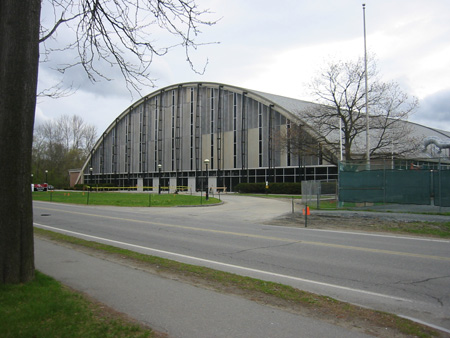
First, the transit report proposes a bus shelter here (pdf).
Second, Athletic Director Harry Sheehy commented in an interview in the Alumni Magazine that the school needs another field house. Chase Fields seems a likely site, and the building could even take over a part of the Thompson parking lot facing South Park Street.
Third, the owner of the private house just below the entrance to the parking lot, at 31 1/2 South Park Street, has demolished the building and is replacing it with a three-story building containing a dental office with apartments above (Planning Board minutes Sept. 13 (pdf); see also Planning Board minutes Sept. 6 (pdf)).
All of this activity gets one thinking about the two old houses in front of Thompson Arena at 25 and 27 South Park Street, both designed by Jens F. Larson.
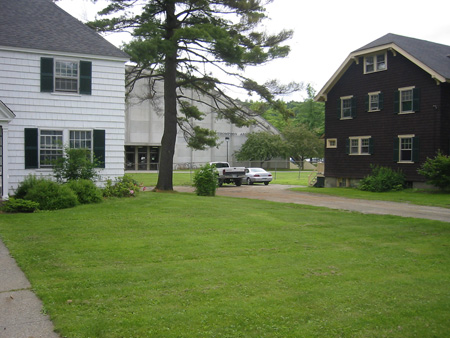
On the one hand, the presence of the two houses preserves the historic appearance of the east side of the street and maintains the rhythm of solids and voids that stretches all the way up to Wheelock Street. Number 29, the Fire & Skoal house, is also a Larson product.
The view that the houses frame is interesting and surprising — it looks like there is some kind of hangar back there, and a walk along the beach-flat ground that reveals the ribs and upturned hulk of Thompson behind the brown shingled house can create a nautical impression. Removing the houses to create a plaza would be a bit arbitrary: very few people actually walk from the front door of Leverone to the front door of Thompson.
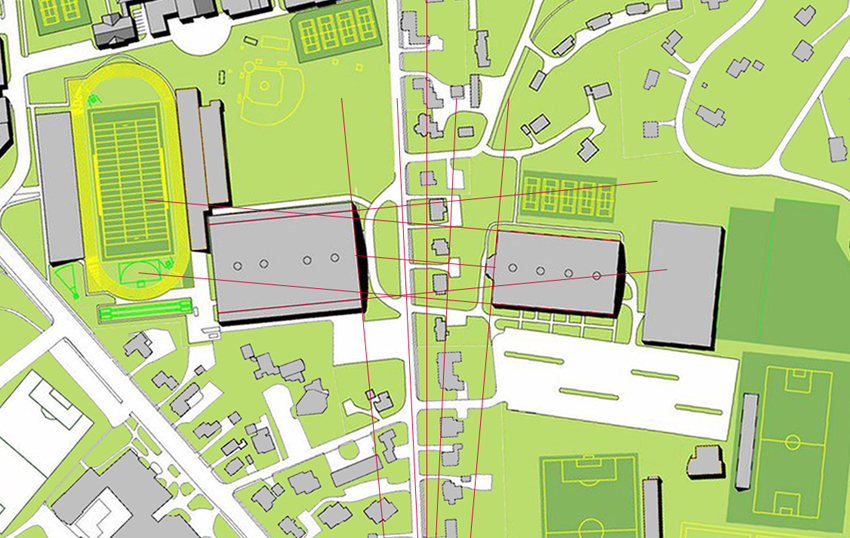
On the other hand, the two Nervi buildings were meant to face each other, and the two houses have always been meant to come out. Master plans have long proposed that the houses be removed and a plaza be constructed to link the two concrete arenas. The 2007 Landscape Master Plan included such a proposal (pdf). The 2000 student life master plan (pdf) notes that the entry into Thompson Arena is obscured by existing houses along Park Street:
There are, however, opportunities to reinforce the entry to Thompson Arena by moving or demolishing the College-owned houses on Park Street in front of the current entry. Doing so would relate the Arena to its cousin, Leverone Field House, both designed by Pier Luigi Nervi, and complete an intention planned but never realized.
II. Proposal
The two Larson houses at 25 and 27 could be moved across the street, above Cobra, and a plaza could be built in their place.
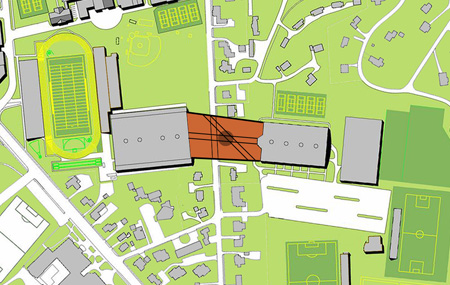
The plaza would be difficult to make uniform in footprint. The two Nervi buildings do not face each other directly. Each stands a different distance from the street and rises to a different height.
Piazza Nervi would become the student entrance to the whole Chase Fields complex. Pedestrians walking down Park Street would swing diagonally across the Thompson forecourt and then head eastward. The present route into the parking lot is relatively convoluted and disappointing.
As a bonus, the piazza could tie into a new path cut westward through the Crosby-Park block. The need for this path to Lebanon Street, the only cross-block route between Wheelock and Summer Streets, has been obvious for years, and the Ped/Bike Master Plan released in October (pdf) recommends it. A long brick wall built to shield the neighbors’ houses could serve as a venue for a horizontal climbing race put on by the DOC: speed-bouldering.
III. Conclusion
The new piazza would be the first work of architecture of any kind in Hanover — whether a plaque, monument, room, or building — dedicated to an architect.
It would make a nice gateway for drivers entering the campus from the southeast. That might be its most important function.
The danger is that Piazza Nervi would be a windswept Modernist wasteland: there is a fine line between minimalism and barrenness. But something good is possible.
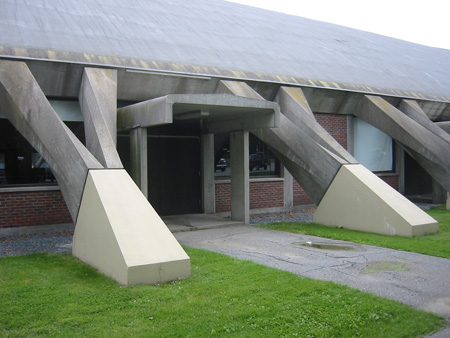
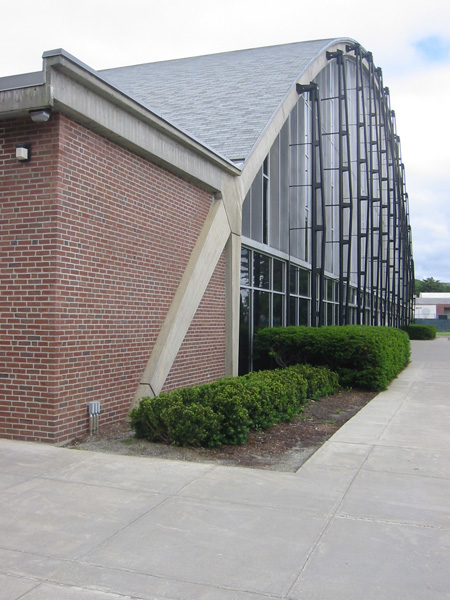
—–
[Update 11.17.2012: Broken link to oblique image fixed.]
[Update 06.10.2012: Link to and quote from 2000 master plan added. Thanks to Big Green Alert: The Blog for the link here and ideas.]
Unbuilt Dartmouth, an exhibit and an article
A graphical article based on research by Barbara Krieger in the July/August Alumni Magazine nicely covers a larger exhibit in the History Room in Baker. It is good to see the site for the amphitheater named as Murdough rather than the Bema, which is the site that that drawing is usually said to describe.
One or two quibbles: the 1931 courtyard Inn on page 53 was meant not not the Robinson Hall area but for the Spaulding Auditorium site, as is shown on the exhibit’s Dartmouth House Plot Plan. The gateway shown in the Larson drawing would have faced east, and Lebanon Street is depicted on the left of the drawing. (The main block of the current Inn was completed in 1967 rather than 1887.)
The focus on the Dartmouth Hall cupola is a bit of a wild goose chase. The plans depicted are by William Gamble and show a masonry building that was never built. Dartmouth Hall was built from some other plans, long since lost, that almost certainly showed a cupola. Those plans might or might not have been by Gamble and probably were not by Peter Harrison. (The cupola that Tucker admired was probably a somewhat different midcentury replacement for the original.)
Here is an image that did not make it into the article, a pre-Leverone proposal for a field house by Eggers & Higgins:
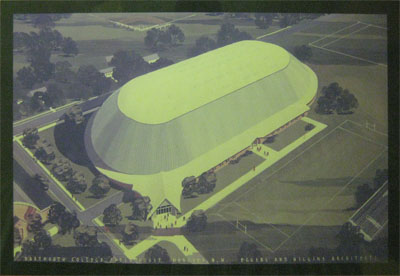
Wow. That is a view to the southeast from above the gym. South Park Street runs behind the field house, and the field in the upper right corner is the site of the later Leverone Field House.
The article quotes Eisenhower on “what a college ought to look like.” Conan O’Brien recently paraphrased this commentary while adding something of his own:
It’s absolutely beautiful here, though. It is the quintessential college cam-… American college campus. It does look like a movie set.
(Video, at 1:27.)